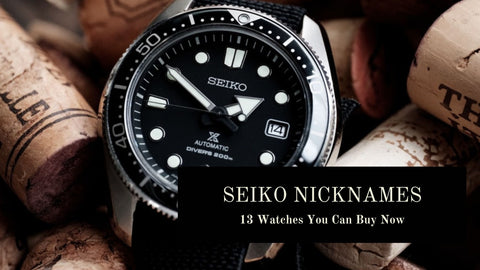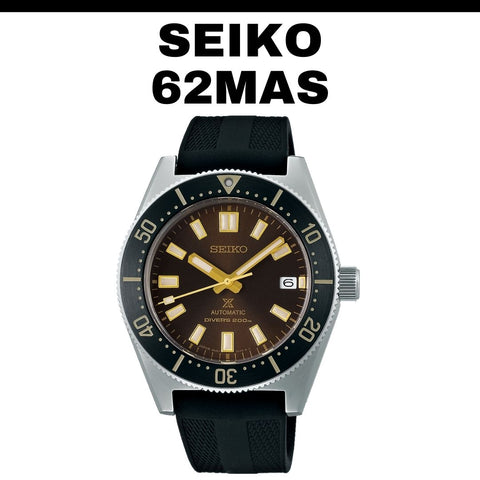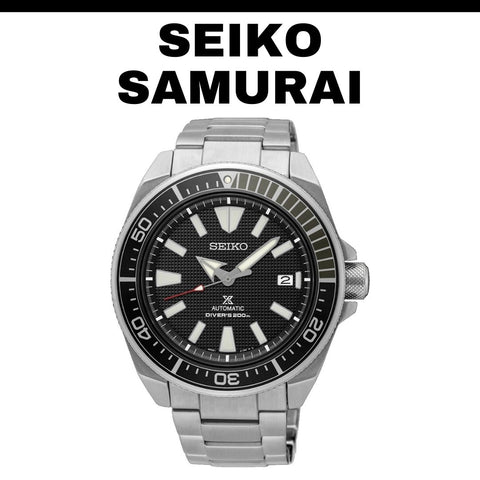Posted on April 15 2024
This site contains affiliate links for which I may be compensated

How many brands do you know where customers have renamed the products?
Think about that for a second.
Customers creating their own unique names for a brands products.
It only happens with a few companies. And when it does, the nicknames become as important as the real name.
It's what every brand would want. Fully committed and enthusiastic buyers who create their own language when discussing the brand.
With watches, there are only a couple of companies that have reached this point. Swiss legends Rolex and Japan's Seiko.
Yes, others may have the odd model with an affectionate name, but only these two have a series of watches with distinctive nicknames.
Let's look at the current Seiko watches that have been renamed by their fans.
Think about that for a second.
Customers creating their own unique names for a brands products.
It only happens with a few companies. And when it does, the nicknames become as important as the real name.
It's what every brand would want. Fully committed and enthusiastic buyers who create their own language when discussing the brand.
With watches, there are only a couple of companies that have reached this point. Swiss legends Rolex and Japan's Seiko.
Yes, others may have the odd model with an affectionate name, but only these two have a series of watches with distinctive nicknames.
Let's look at the current Seiko watches that have been renamed by their fans.
Why Do Seiko Watches Have Nicknames?
Seiko watches have been renamed by their fans for a number of simple reasons.
Firstly, Seiko gives their watches reference numbers that for the most part don't mean much to buyers.
Take MWC for example. They'll give a reference number like DIV/82SS/AU/ND. It's easy to figure out. It's a dive watch in the 1982 style with a stainless steel case, automatic movement and no date window.
Seiko will label a watch SPB153J1.
It doesn't mean much to the average watch buyer. But call the watch the Captain Willard model and then we all know that it's the watch that Martin Sheen wore in Apocalypse Now.
Another reason is the size of the brand.
Seiko is a massive watch producer. Nicknames distinguish the models from each other. And when models are similar, so are the names. So we have a Seiko Monster and a smaller Baby Monster.
Finally, nicknames allow watch nerds to indulge their passion. Names with meaning trump generic model numbers. It's more fun to chat about the Sumo or Turtle than it is the SPB103J1 or SRPE99K1.
And those names often refer to the design or the character of the watch. They give us information about the style. The Sumo isn't going to be a dainty piece.
Seiko Nicknames
But the list of Seiko nicknames can seem never-ending. There has to be a cut-off point. For me, I've chosen what seems obvious.
My list only includes Seiko watches that are easy to buy brand new.
Yes, the Seiko Pogue is an iconic space watch. But it's discontinued. So it doesn't make the list. I'm only including models that you can buy now. And I'm opening the list with one of my favourite Seiko models.

This is a stunning watch that demonstrates why some watches become iconic. The 62MAS was Seiko and Japan's first dive watch.
The original was a distinctive and functional piece with the appearance of a classic Skin Diver's watch. That means a slim case with prominent lugs and a simple black bezel.
First released in 1965, this watch influenced many later Seiko diver's. Forget about references numbers. Watch fans know the various versions of this watch as the 62MAS.
It was a straightforward automatic watch. But it had 150M of water resistance. That was impressive when previous Seiko watches could only boast 50M.
At the time of the watches release, manufacturers were breaking new dive records. Diver's were going ever deeper - for both work and recreation. But not everyone into dive watches needed that functionality.
Watch companies spotted a gap and began to release lighter, slimmer dive watches. These were aimed at more casual divers.
It was at this point that Seiko built their debut dive watch. The name 62MAS comes from the watches features - an autoMAtic Selfdater.
If you're familiar with Skin Diver watches you'll recognise that DNA in the Seiko.
Skin Diver watches of the time had generic cases (often built by Squale). So this watch has an angular case with pronounced lugs. This is matched with a simple rotating bezel.
The dial is also familiar to fans of vintage Seiko divers. It has simple rectangular markers and straight hands. But despite these common features, it's a beautiful design. And this modern reinterpretation successfully captures the dive watch chic of the time.
The new model isn't a replica of the original.
The case is larger, as are the hands. The bezel is chunkier and more modern looking and the whole watch looks a little crisper than the 1960s watch.
And of course, the new version has gold hands and accents.
Technically, the reissue is an upgrade of the original. The water resistance is increased from 150 to 200M and the modern Seiko movement is an improvement. Of all the Seiko watches known by nicknames, this is arguably the best.
The original was a distinctive and functional piece with the appearance of a classic Skin Diver's watch. That means a slim case with prominent lugs and a simple black bezel.
First released in 1965, this watch influenced many later Seiko diver's. Forget about references numbers. Watch fans know the various versions of this watch as the 62MAS.
It was a straightforward automatic watch. But it had 150M of water resistance. That was impressive when previous Seiko watches could only boast 50M.
At the time of the watches release, manufacturers were breaking new dive records. Diver's were going ever deeper - for both work and recreation. But not everyone into dive watches needed that functionality.
Watch companies spotted a gap and began to release lighter, slimmer dive watches. These were aimed at more casual divers.
It was at this point that Seiko built their debut dive watch. The name 62MAS comes from the watches features - an autoMAtic Selfdater.
If you're familiar with Skin Diver watches you'll recognise that DNA in the Seiko.
Skin Diver watches of the time had generic cases (often built by Squale). So this watch has an angular case with pronounced lugs. This is matched with a simple rotating bezel.
The dial is also familiar to fans of vintage Seiko divers. It has simple rectangular markers and straight hands. But despite these common features, it's a beautiful design. And this modern reinterpretation successfully captures the dive watch chic of the time.
The new model isn't a replica of the original.
The case is larger, as are the hands. The bezel is chunkier and more modern looking and the whole watch looks a little crisper than the 1960s watch.
And of course, the new version has gold hands and accents.
Technically, the reissue is an upgrade of the original. The water resistance is increased from 150 to 200M and the modern Seiko movement is an improvement. Of all the Seiko watches known by nicknames, this is arguably the best.
Seiko Prospex 1965 62MAS Reissue SPB147J1
|

This is a watch with a story. And that's the perfect reason for giving the watch a memorable name.
The Seiko Captain Willard is a similar offering to the 62MAS. It's one of Seiko's most iconic divers and a favourite among the brand's fans.
The Seiko Captain Willard was a real Seiko watch that was first released in 1968. Officially known as the Seiko 6105, it was a tough dive watch that was on sale in Vietnam during the war.
It's a great watch in its own right. It had 150M of water resistance, an in-house automatic movement and a very distinctive 'turtle' case.
But the watches real fame comes from Hollywood. In Apocalypse Now, Martin Sheen's character - Captain Willard - wore the Seiko 6105.
There have been a few reissues by Seiko, with this green version being my favourite. Let's not worry that Sheen wore the black variation onscreen.
Surprisingly, the reissue is slightly smaller than the original. As a fan of smaller watches that is a plus for me. But at 42mm, this isn't a small watch. It's just more compact than the original
Stylistically, it's closer to the original.
The beautiful green version has a strong military vibe. I like that. The turtle or cushion case looks like a vintage diver. But the drab green feels authentic to the time period and its use in Vietnam.
But the watch is a legitimate diver and has 200M of water resistance. And the other specs are good too - they should be - this isn't an inexpensive watch.
It has a sapphire crystal and a Seiko in-house automatic movement with a 70-hour power reserve.
But it's the design that wins here. It's instantly recognisable and has been popular since the 1970s.
The Seiko Captain Willard is a similar offering to the 62MAS. It's one of Seiko's most iconic divers and a favourite among the brand's fans.
The Seiko Captain Willard was a real Seiko watch that was first released in 1968. Officially known as the Seiko 6105, it was a tough dive watch that was on sale in Vietnam during the war.
It's a great watch in its own right. It had 150M of water resistance, an in-house automatic movement and a very distinctive 'turtle' case.
But the watches real fame comes from Hollywood. In Apocalypse Now, Martin Sheen's character - Captain Willard - wore the Seiko 6105.
There have been a few reissues by Seiko, with this green version being my favourite. Let's not worry that Sheen wore the black variation onscreen.
Surprisingly, the reissue is slightly smaller than the original. As a fan of smaller watches that is a plus for me. But at 42mm, this isn't a small watch. It's just more compact than the original
Stylistically, it's closer to the original.
The beautiful green version has a strong military vibe. I like that. The turtle or cushion case looks like a vintage diver. But the drab green feels authentic to the time period and its use in Vietnam.
But the watch is a legitimate diver and has 200M of water resistance. And the other specs are good too - they should be - this isn't an inexpensive watch.
It has a sapphire crystal and a Seiko in-house automatic movement with a 70-hour power reserve.
But it's the design that wins here. It's instantly recognisable and has been popular since the 1970s.










0 comments